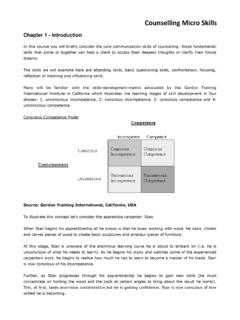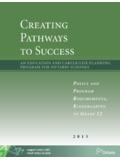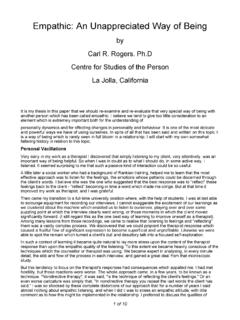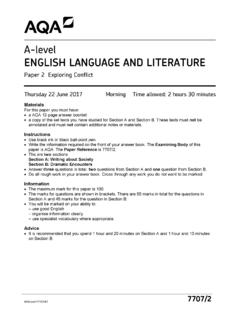Transcription of Counselling Micro Skills - AIPC
1 Counselling Micro Skills Chapter 1 - Introduction In this course you will briefly consider the core communication Skills of Counselling : those fundamental Skills that alone or together can help a client to access their deepest thoughts or clarify their future dreams. The Skills we will examine here are attending Skills , basic questioning Skills , confrontation, focusing, reflection of meaning and influencing Skills . Many will be familiar with the Skills -development-matrix advocated by the Gordon Training International Institute in California which illustrates the learning stages of skill development in four phases: 1. unconscious incompetence, 2: conscious incompetence, 3: conscious competence and 4: unconscious competence. Conscious-Competence Model Source: Gordon Training International, California, USA. To illustrate this concept let's consider the apprentice carpenter, Stan. When Stan begins his apprenticeship all he knows is that he loves working with wood.
2 He saws, chisels and carves pieces of wood to create basic sculptures and amateur pieces of furniture. At this stage, Stan is unaware of the enormous learning curve he is about to embark on ( he is unconscious of what he needs to learn). As he begins his study and watches some of the experienced carpenters work, he begins to realise how much he has to learn to become a master of his trade. Stan is now conscious of his incompetence. Further, as Stan progresses through his apprenticeship he begins to gain new Skills (he must concentrate on holding the wood and the tools at certain angles to bring about the result he wants). This, at first, takes enormous concentration but he is gaining confidence. Stan is now conscious of how skilled he is becoming. Finally, Stan completes his apprenticeship and goes on to open his own business. In a few years, he is making wonderful pieces of furniture, hardly thinking about what he has to do to bring about the exquisite results he produces.
3 Stan is now unconsciously competent. He simply does his work, barely paying attention to the process (sometimes signing along to the radio in the background). He no longer has to concentrate on every stage of his work. In the same way, professionals build their Skills in communication by progressing through these stages. Professionals who are finding the use of Micro Skills awkward or difficult are likely to be in the consciously incompetent stage. Professionals who are using the Skills effectively but feel a little unnatural or awkward, are likely to be consciously competent. And Professionals who have learnt the Skills thoroughly and are no longer immediately aware that they are using the Skills are unconsciously competent. It can be reassuring to know that you will progress through the skill-development matrix. It is only a matter of time and practice before you master the Skills and they become second nature to you.
4 SUMMARY OF Counselling Skills . Micro -skill Purpose When it's used Examples Attending behaviours Throughout entire Counselling Attentive body language encourage clients to talk Attending interview. Particularly (eye contact, leaning and show that the Behaviour important in the initial stages forward slightly, counsellor is interested in of establishing rapport. encouraging gestures). what's being said. Effective questioning Questioning is useful in the What would you like to helps guide the information gathering stage of talk about today? . Counselling conversation the interview. It can however Questioning and may assist in be an important skill to use When does the problem enriching the client's throughout the entire occur? . story. process. Accurate Responding Responding is useful Let me see if I've got this allows the counsellor to throughout all stages of a right. You want to go back Responding confirm with the client Counselling interview.
5 It helps to full time study but are that they are being heard the counsellor to clarify and worried about your correctly. encourage clients' stories. financial commitments? . Noting and reflecting can assist in adding the emotional You feel disappointed Noting and reflecting is dimension to the client's Noting and because your mother used to bring out story, so is often used in the Reflecting didn't call you on your underlying feelings. interview stages of gathering birthday.. information and exploring alternatives. Skilled client observation allows the counsellor to Observation is a skill that is Observing body language, Client identify discrepancies or utilised throughout the entire tone of voice and facial Observation incongruities in the Counselling interview. expressions. client's or their own communication. Confrontation is often used Confrontation is a skill when the counsellor observes that can assist clients to mixed messages or increase their self- You say you would like to incongruities in the client's awareness.
6 It can be used do further study but you Confrontation words, behaviours, feelings or to highlight discrepancies haven't contacted the thoughts. Confrontation that clients have training institution.. should only be used after previously been unaware rapport has been developed of. between client and counsellor. After noticing that a client Focusing is a skill that is has mentioned very little Focusing enables a relevant to all stages of a about his family, the counsellor to direct Focusing Counselling interview. This counsellor, (believing the client's conversational skill however should be used family is relevant) directs flow into certain areas. sparingly. the conversation toward the client's family. A young person has just Influencing is generally used started taking drugs. The Influencing may facilitate when the client is exploring counsellor discusses the Influencing change in the way a client alternative ways of thinking possible long and short chooses to think or act.
7 Or behaving. term consequences of his/her actions. Chapter 2 Attending Behaviour Attending is the behavioural aspect of building rapport. When a counsellor first meets with a client, they must indicate to the client that they are interested in listening to them and helping them. Through attending, the counsellor is able to encourage the client to talk and open up about their issues. Eye contact is important and polite (in Western society) when speaking or listening to another person. This does not mean that the counsellor stares at the client, but maintains normal eye contact to show genuine interest in what the client is saying. Geldard and Geldard (2001) suggest that to assist clients to relax, counsellors can include in their repertoire, the matching of non-verbal behaviour. This skill can take a little time to learn effectively, but it begins with the counsellor sitting in the same position as the client. For example, if at first the client is sitting on the edge of her chair with her arms outstretched resting on her knees the counsellor can reflect or mirror this position.
8 As the client speaks more, the counsellor can either lean forward, to indicate empathy and understanding, or slowly slide back into the chair to take up a more relaxed sitting position. If the rapport has begun to be built between client and counsellor, the client is likely to follow suit. This will reduce the anxiety levels for the client. Counselling consists mainly of listening and talking, but sometimes the use of silence can have profound effects on the client in the Counselling session. When we first begin as counsellors , sometimes silence can be awkward and we rush to fill the gaps, but as our experience grows, we become more comfortable with the concept of simply being with the client. Chapter 3 - Questioning Questions during the Counselling session can help to open up new areas for discussion. They can assist to pinpoint an issue and they can assist to clarify information that at first may seem ambiguous to the counsellor.
9 Questions that invite clients to think or recall information can aid in a client's journey of self-exploration. counsellors should be knowledgeable about the different types of questioning techniques, including the appropriate use of them and likely results. It is also important to be aware and cautious of over- questioning. Asking too many questions sends a message to the client that the counsellor is in control and may even set up a situation in which the client feels the counsellor has all the answers. In determining effective questioning techniques it is important to consider the nature of the client, their ongoing relationship with the counsellor and the issue/s at hand. There are two main types of questions used in Counselling : (1) Open and (2) Closed. Open questions Open questions are those that cannot be answered in a few words, they encourage the client to speak and offer an opportunity for the counsellor to gather information about the client and their concerns.
10 Typically open questions begin with: what, why, how or could. For example: 1. What has brought you here today? 2. Why do you think that? 3. How did you come to consider this? 4. Could you tell me what brings you here today? How questions tend to invite the client to talk about their feelings. What questions more often lead to the emergence of facts. When questions bring about information regarding timing of the problem, and this can include events and information preceding or following the event. Where questions reveal the environment, situation or place that the event took place, and Why questions usually give the counsellor information regarding the reasons of the event or information leading up to the event. How? Most often enables talk about feelings and/or process. What? Most often lead to facts and information. When? Most often brings out the timing of the problem, including what preceded and followed it.




